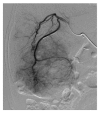Is there still a role for the hepatic locoregional treatment of metastatic neuroendocrine tumors in the era of systemic targeted therapies?
- PMID: 28487601
- PMCID: PMC5403743
- DOI: 10.3748/wjg.v23.i15.2640
Is there still a role for the hepatic locoregional treatment of metastatic neuroendocrine tumors in the era of systemic targeted therapies?
Abstract
Gastroenteropancreatic neuroendocrine neoplasms (GEP-NENs) frequently present with distant metastases at the time of diagnosis and the liver is the most frequent site of spreading. The early identification of metastatic disease represents a major prognostic factor for GEP-NENs patients. Radical surgical resection, which is feasible for a minority of patients, is considered the only curative option, while the best management for patients with unresectable liver metastases is still being debated. In the last few years, a number of locoregional and systemic treatments has become available for GEP-NEN patients metastatic to the liver. However, to date only a few prospective studies have compared those therapies and the optimal management option is based on clinical judgement. Additionally, locoregional treatments appear feasible and safe for disease control for patients with limited liver involvement and effective in symptoms control for patients with diffuse liver metastases. Considering the lack of randomized controlled trials comparing the locoregional treatments of liver metastatic NEN patients, clinical judgment remains key to set the most appropriate therapeutic pathway. Prospective data may ultimately lead to more personalized and optimized treatments. The present review analyzes all the locoregional therapy modalities (i.e., surgery, ablative treatments and transarterial approach) and aims to provide clinicians with a useful algorithm to best treat GEP-NEN patients metastatic to the liver.
Keywords: Ablation; Chemoembolization; Gastroenteropancreatic neuroendocrine neoplasms; Liver metastases; Locoregional therapies; Systemic therapies.
Conflict of interest statement
Conflict-of-interest statement: The authors declare no conflict of interest related to this publication.
Figures



Similar articles
-
NEN: Advancement in Diagnosis and Minimally Invasive Therapy.Rofo. 2020 May;192(5):422-430. doi: 10.1055/a-1030-4631. Epub 2019 Nov 20. Rofo. 2020. PMID: 31747704 Review. English.
-
Ablative therapies for liver metastases of gastroenteropancreatic endocrine tumors.Neuroendocrinology. 2004;80 Suppl 1:74-8. doi: 10.1159/000080746. Neuroendocrinology. 2004. PMID: 15477722 Review.
-
Treatment options for unresectable neuroendocrine liver metastases.Expert Rev Gastroenterol Hepatol. 2012 Jun;6(3):357-69. doi: 10.1586/egh.11.60. Expert Rev Gastroenterol Hepatol. 2012. PMID: 22646257 Review.
-
Systemic treatment of neuroendocrine tumors with hepatic metastases.Turk J Gastroenterol. 2012;23(5):427-37. doi: 10.4318/tjg.2012.0552. Turk J Gastroenterol. 2012. PMID: 23161287 Review.
-
Aggressive Locoregional Treatment Improves the Outcome of Liver Metastases from Grade 3 Gastroenteropancreatic Neuroendocrine Tumors.Medicine (Baltimore). 2015 Aug;94(34):e1429. doi: 10.1097/MD.0000000000001429. Medicine (Baltimore). 2015. PMID: 26313798 Free PMC article.
Cited by
-
A Neuroendocrine Tumor of Unknown Primary Origin: A Case Report and Review of the Literature.Cureus. 2024 Jul 23;16(7):e65200. doi: 10.7759/cureus.65200. eCollection 2024 Jul. Cureus. 2024. PMID: 39176372 Free PMC article.
-
Interventional Radiology in the Era of Radiotheranostics: An Update for Interventional Radiologists!Semin Intervent Radiol. 2022 Dec 20;39(6):587-590. doi: 10.1055/s-0042-1759703. eCollection 2022 Dec. Semin Intervent Radiol. 2022. PMID: 36561794 Free PMC article. Review. No abstract available.
-
Analysis of B-ultrasound and contrast-enhanced ultrasound characteristics of different hepatic neuroendocrine neoplasm.World J Gastrointest Oncol. 2019 May 15;11(5):436-448. doi: 10.4251/wjgo.v11.i5.436. World J Gastrointest Oncol. 2019. PMID: 31139313 Free PMC article.
-
Gastroenteropancreatic Neuroendocrine Neoplasia Characterization in Portugal: Results from the NETs Study Group of the Portuguese Society of Endocrinology, Diabetes and Metabolism.Int J Endocrinol. 2019 Aug 1;2019:4518742. doi: 10.1155/2019/4518742. eCollection 2019. Int J Endocrinol. 2019. PMID: 31467527 Free PMC article.
-
Clinicopathological Characteristics of the primary and metastatic Hepatic Neuroendocrine Tumors and the relevant Prognosis-Related Factors: A Retrospective Study of 81 Cases in a Single Chinese Center.J Cancer. 2018 Jan 1;9(3):479-487. doi: 10.7150/jca.22157. eCollection 2018. J Cancer. 2018. PMID: 29483952 Free PMC article.
References
-
- Modlin IM, Lye KD, Kidd M. A 5-decade analysis of 13,715 carcinoid tumors. Cancer. 2003;97:934–959. - PubMed
-
- Yao JC, Hassan M, Phan A, Dagohoy C, Leary C, Mares JE, Abdalla EK, Fleming JB, Vauthey JN, Rashid A, et al. One hundred years after “carcinoid”: epidemiology of and prognostic factors for neuroendocrine tumors in 35,825 cases in the United States. J Clin Oncol. 2008;26:3063–3072. - PubMed
-
- Rindi G, Arnold R, Bosman F, Capella C, Kilmstra D, Kloppel G. Nomenclature and classification of neuroendocrine neoplasms of the digestive system. In: Bosman FT et al, editor. WHO Classification of Tumours of the Digestive System. Lyon: IARC Press, 2010: 13-14 In: Bosman FT et al., editor.
-
- Saxena A, Chua TC, Sarkar A, Chu F, Liauw W, Zhao J, Morris DL. Progression and survival results after radical hepatic metastasectomy of indolent advanced neuroendocrine neoplasms (NENs) supports an aggressive surgical approach. Surgery. 2011;149:209–220. - PubMed
Publication types
MeSH terms
LinkOut - more resources
Full Text Sources
Other Literature Sources
Medical

